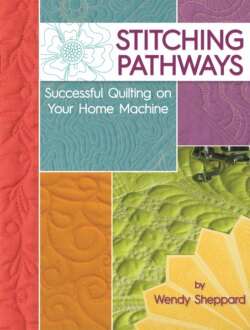Читать книгу Little Book of Wooden Bowls - Wendy Sheppard - Страница 7
На сайте Литреса книга снята с продажи.
ОглавлениеKEYS TO FREE-MOTION SUCCESS
FREE-MOTION QUILTING AND TAKING THE PLUNGE
“Free-motion” is quilting with the feed dogs of your machine disengaged. You can stitch forward, backward, or side-to-side and never have to turn your project. Your hands become the tool that moves the quilt as you stitch. You can stitch freely in any direction using creative shapes to quilt your quilt. And it’s easy to do on your home machine! Even when my quilting friends are hesitant, I always encourage them to jump in and give domestic machine quilting a try. Most of the time, quilting their own quilts creates a feeling of great satisfaction, too. Techniques, tips, and tricks fill the pages of this book to start you on your own path to machine quilting.
PRACTICE, PRACTICE, PRACTICE!
Practice makes perfect. The more you practice, the better your quilting will be. First, doodle on paper to see how the direction of each movement takes you along a path. Then, make several quilt sandwiches and practice with your home machine.
MUSCLE MEMORY AND MANEUVERING THE QUILT SANDWICH
One thing to be mindful of is that the feed dogs are disengaged when you’re moving a quilt sandwich. With nothing to move it as you stitch, your hands, arms and muscles become the “feed dogs” and they have the job of maneuvering your quilt under the needle. Muscle memory refers to repeating a movement, over and over, until it becomes second nature. See how moving the sandwich and changing the speed of your machine will change your stitch length.
MY FAVORITE TOOLS AND NOTIONS
Like any kind of sewing or quilting, we find tools that work best to accomplish what we want to do. I’m sharing my favorites because they work for me and if you are unsure of what tools, thread, batting and other notions you need to start free-motion quilting, you can try my favorites to get started. I can’t stress the importance of thread, batting and needle choice. Besides your machine, these notions may be the most important choices you make when you start out.
BUILD FROM THE BASICS
I like to start my students quilting echoes. Echoing is simply sewing around the edge of a shape and then stitching another line a small distance away from the first. It is the most basic motif in machine quilting that builds muscle memory, muscle control, and the ability to maneuver curves. I also teach my students to look at the needle and where it lands. Training your eyes in this way and not relying on the edges of a machine foot will help stitches land accurately. This is important as you begin to learn the basics.
IMPORTANCE OF DOODLING
I recommend that you doodle with a pencil or pen on paper before using your machine to quilt your design. It’s great practice and you can visualize where to go next from one area to another. While doodling may seem like such a simple process, it helps you think about how a particular quilting path affects the next direction a stitch should take. When you feel comfortable doodling on paper, try it out on a practice sandwich.
PRACTICE SANDWICHES
I suggest to my friends to first try out quilting motifs by making practice sandwiches. Sandwiches are a great way to test the scale of a motif, correct and experiment with thread tension, and movement. Use a light solid color fabric and contrasting thread so you can easily see your stitches. Make several sandwiches at a time to have on hand when you want to try a new technique. This is also a great way to use up scrap fabric and batting pieces you have saved.
Refer here to make a practice sandwich.
PANELS AND FOLLOWING THE LINES
I encourage beginning quilters to jump right into the quilting part by using printed panels. Time is saved just by layering the quilt sandwich and getting right to the business of quilting! Quilt panels that have motifs and designs already printed on them make it easy to practice follow-the-line quilting. Stitch slowly. This will help you see where to go next, and reduces the chance of snags and jerks, which improves overall stitch quality.
